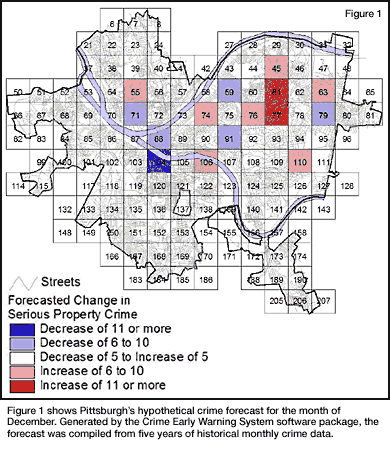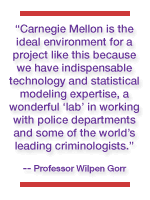|
|
||
|
|
|
 Researchers Develop Crime Prevention Software � What began in 1990 with a grant to develop computerized mapping for police may soon result in software capable of predicting the number and type of crimes that will occur in a given area. Through a grant from the National Institute of Justice, Carnegie Mellon researchers have developed the Crime Early Warning System software package, a crime-forecasting computer application that can calculate the possibility of crime within a 100-block area. By evaluating criminal reports, past crime history, crime trends, 911 calls and seasonal variations, the software produces a forecast that helps direct police to possible future problem areas.
In 1990, Pittsburgh was among five U.S. cities chosen to receive funding to develop computerized mapping to aid street-level drug-enforcement officials. After working on the project, Heinz School Ph.D. student Andres Olligschlaeger wrote a dissertation on crime forecasting, proposing a system based on neural network modeling. His ideas soon received attention from crime-mapping specialists and generated four new National Institute of Justice grants. Heinz School researchers Wilpen Gorr and Jacqueline Cohen also received a grant. "Carnegie Mellon is the ideal environment for a project like this because we have indispensable technology and statistical modeling expertise, a wonderful 'lab' in working with police departments and some of the world's leading criminologists," Gorr said. "You put all three of those factors together and you've got dynamite!" After completing the final tests on the project, researchers will begin testing the forecasting package in Pittsburgh and Rochester, N.Y. Come December, they hope to have the software available for use nationwide. � � � � � �
�
Top�
�
�
Bethany Elder
|
|
This Issue's Headlines || Carnegie Mellon News Home || Carnegie Mellon Home |
||
 "This project is a wonderful model of how to spend public funds on research where there is big pay off," said Wilpen Gorr, professor of pubic policy and management information systems.
"This project is a wonderful model of how to spend public funds on research where there is big pay off," said Wilpen Gorr, professor of pubic policy and management information systems.